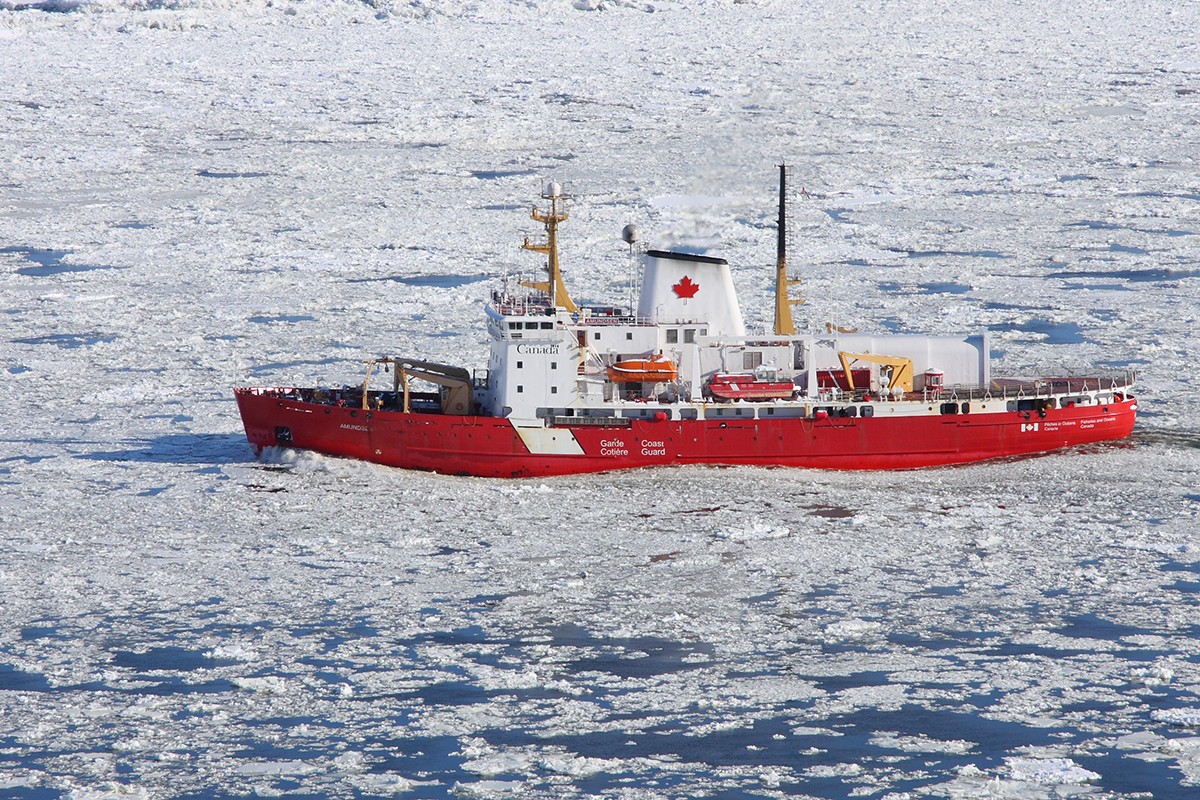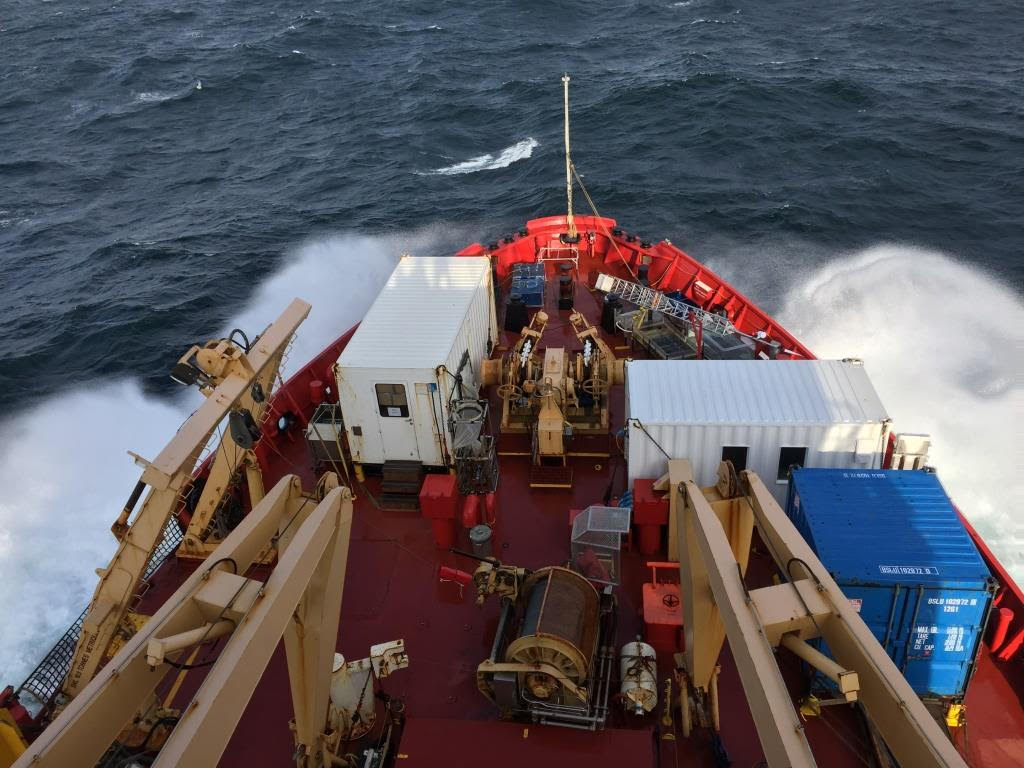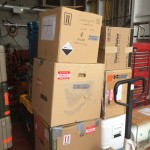
Life at sea
The following is a blog post originally published at ResearchGate.net and written by U of M postdoctoral researcher Kathleen Munson. Munson reports from aboard the NGCC/CCGS Amundsen and discusses what research is like at sea in the arctic.
The Canadian GEOTRACES mercury team left Québec City 10 July 2015 after four days of unpacking boxes, setting up instruments, and storing supplies for 84 days at sea.
I was on the cruise as a last-minute fill-in for my advisor, Fei Wang, to help a PhD student, Kang Wang, maintain instruments, keep up with sample analysis, fine-tune sampling and experiment plans, and assist the GEOTRACES sampling team. I was asked to join the cruise just a few weeks into my new postdoc position. I had the advantage of going to sea after others, especially our technician, Deb, completed the most the difficult parts of cruise planning and preparation. Deb, along with Alexis Burt, was in Québec City to install the instruments and organize the supplies that will allow us to make measurements at sea. My major task on board was to roll with whatever the seas brought and troubleshoot problems that arose on the journey from Québec City to Clyde River for the first two weeks of the trip. Afterwards I was supposed to return to Winnipeg, but on land and at sea, plans don’t always pan out.

The University of Manitoba team during cruise mobilization on deck of the Amundsen in Québec City, Québec. Alexis Burt, Kang Wang, Deb Armstrong, and Kathleen Munson (left to right) unpack boxes and install equipment. // Photo by Alexis Burt
We have two major components of our project: measuring atmospheric mercury and measuring seawater mercury. Although the Amundsen has built-in laboratory space, we work in “vans”—containers that serve as portable lab spaces—located near the bow and stern of the ship. Our atmospheric sampler is located at the bow of the boat while our Portable In-Site Laboratory for Mercury Speciation (PILMS), where we measure mercury in water samples, is just forward of the helicopter pad on the back deck of the Amundsen.
In addition to our University of Manitoba group, there is a bonus member of the mercury team on the Amundsen. Priyanka Chandan, from the University of Toronto, is collecting aerosol samples that she will analyze for mercury as well as other metals. During the first days of the cruise, when most of the members of the ship’s science party were setting up their lab spaces, Priyanka and I were already collecting atmospheric mercury data.

The bow of the NGCC/CCGS Amundsen. Our lab’s atmospheric mercury sampler is visible on the starboard (right) bow above the blue container and to the right of the white container, which housed the instrument’s computer, pump, and analysis units. // Photo by Kang Wang
A Very Long Two Weeks
The transit up the St Lawrence River gave me time to familiarize myself with the atmospheric instrument, something I had seen other groups use on past cruises, but had never been responsible for until then. With help from the ships’ engineers, we had secured the atmospheric sampling unit to a stand near the bow of the ship, which would allow us to sample air upstream of potential contamination from the ship’s exhaust. An air pump and mercury detector were located in the starboard container, just to the side of the sampling unit. For the first few days of the cruise, I walked back and forth between the starboard container and the two science computers four levels above to exchange emails with Deb back in Winnipeg as I learned how to adjust the settings on the instrument.
During those first days at sea, I also spent many hours troubleshooting our total mercury analyzer in PILMS to improve its sensitivity. Together Priyanka and I worked out mechanical problems, including identifying and replacing leaking tubing within the instrument, dismantling the mercury detector to clean the delicate quartz cuvette that allows for proper quantification of mercury fluorescence, and purging the reagents we use in our sample preparation of any contamination that would hinder our ability to measure the low concentrations of dissolved mercury in seawater.
I was busy working on processing the samples we had collected from our first station in the Labrador Sea on 19 July. With only four days left until my departure, I was feeling optimistic that the instruments were responding well and we were part of a good team working to get samples that were free of contamination. Wen Xu, our lab research assistant, would fly to Clyde River the next day to replace me on board. I would be wishing her and Kang good luck for the rest of the cruise and returning to my desk in Winnipeg.

A few of the 50 assorted boxes, coolers, and totes shipped from the University of Manitoba to Québec City, Québec containing the equipment needed to set up our seagoing laboratory. // Photo by Alexis Burt
Our plans changed dramatically that afternoon when we were told that the Amundsen was diverted from its scientific duties to break ice in the Hudson Bay. I quickly wrote Wen an email telling her not to travel north until further notice and waited with the rest of the science party to find out how the diversion would impact our science plan.
The twelve days we spent in the Hudson Bay emphasized the need to always be ready to adapt to changes at sea. I was fortunate during the delay to still collect atmospheric data and even spent a day doing some instrument surgery to replace a burned out pump. However, we grew nervous with each passing day as the amount of time available for sampling decreased. Because water budgets are tight at every station, we had requested mercury samples at only a subset of the planned cruise stations. As stations were cut, we were unsure of how many stations would remain once we returned to science duties.
We were relieved to hear that we were (finally!) headed back to science duties almost two weeks later. My two-week cruise had by then almost doubled in length yet we had only collected mercury water samples from one station. However, by cutting out portions of the original transit, the altered science plan would be demanding but would still provide valuable insight into mercury cycling in the Arctic.
Sadly, on our way back north to Baffin Bay, the sampling component of the atmospheric system took in a little too much water during the transition from the calm Hudson Bay to the rougher open seas of the Hudson Strait. I was only days away from handing over two working instruments to Wen as she came aboard for the remainder of the cruise. Instead, I had to leave her with notes, an assortment of dismantled parts, and good wishes.
Kathleen Munson moved from Honolulu, Hawai’i to Winnipeg, Manitoba to study how human activity is changing mercury concentrations in cold places. She accompanied University of Manitoba graduate student Kang Wang aboard the NGCC/CCGS Amundsen from Québec City, Québec to Clyde River, Nunavut. Currently, a postdoctoral fellow with Fei Wang and Gary Stern at the University of Manitoba, she did her PhD with Carl Lamborg, who is measuring mercury on board the USCGC Healy in the Bering Sea.
Research at the University of Manitoba is partially supported by funding from the Government of Canada Research Support Fund.







